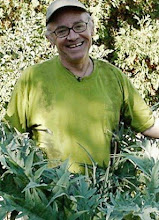 Sunflower sprouts are a great treat you can grow yourself.
Sunflower sprouts are a great treat you can grow yourself. The first real big snowfall of this winter.
The first real big snowfall of this winter. The hoop house took the storm well.
The hoop house took the storm well. These sprouts are ready for light and harvestable in a week.
These sprouts are ready for light and harvestable in a week.
 Harvest time for these sprouts.
Harvest time for these sprouts. One has to clean the seed coats off the sprouts as a fair number do not drop off.
One has to clean the seed coats off the sprouts as a fair number do not drop off. Harvest with a knife or kitchen shears.
Harvest with a knife or kitchen shears. I clean them in cold water and then spin them dry for storage.
I clean them in cold water and then spin them dry for storage. The roots can go on the compost pile or out for the bird to have some winter greens.
The roots can go on the compost pile or out for the bird to have some winter greens.Our recent winter storm brought a white blanket to the garden and covered the cold frames so most of our harvest for 2010 is over.
However, on December 1st I harvested Napa cabbage, sorrel, and some parsley but now most of those are covered with snow. I am not too sure if I will be able to get any parsnips out of the ground this December like last because the ground is really frozen and a nice heavy snow blanket is not drifted on that patch. If snow was over them heavy the ground might warm enough for me to dig them in a few weeks. We are down the the last of the apples for one more batch of applesauce and then that harvest will be gone.
The hoop house held up real well in the storm. High winds ( 30-40 mph) did not seem to bother the plastic and the snow was blowing so much that little accumulation on the house occurred. But we still have a few more months of snow and wind to endure. The snow did pile up on the greenhouse and because the glass is old, I pulled snow off twice in this storm. I don't heat that space, but a sunny day will cause the snow load to slip off. Snow did not slip this time. The drifting as noted in the pictures, made pulling the snow off a bit easier than usual because I could stand on the drifts.
Outside gardening is over, but we are still growing. The first of the Amaryllis are showing nice flower stalks and we are forcing Paper whites. The paper whites are one of the easiest flowers to force in the house, because a bulb is like buying a flower ready to go. Three or five bulbs will make a great show for over two weeks. We have returned to growing sprouts in the basement as well. I have grown three batches of sunflower sprouts recently and let me review how I do that.
I wash the sunflower seed in water with a couple of sprays of Clorox. Afterwords, I rinse them off and let them soak overnight. The next day I drain them and scatter them in a plastic tray that does not have holes. I have been putting a small amount of potting soil in the tray before I scatter the seed. I then pat the seed on that soil bed ( less than a half inch) and mist the seed before I put a dampened sheet of newspaper over the seeds. I use a plastic dome over this and put a bath towel over that. At one time I was putting the tray on a heat mat but that just seemed to promote mold - ugh.
For the next several days I spray the paper and check for germination. Usually in three to four days the roots emerge and then you must be vigilant about water and air. Take the newspaper off and begin to give the seedlings light. I have them next to or sometimes under the florescent light bank that I have in the basement for a few plants that I winter over. Keep the growing seed mois,t and add water the the tray. In less than two weeks you will have a nice crop of spouts.
I then cut half of the tray and clean them as some of the seed coats do not fall off the cotyledons as they grow. Cleaning is in a sink of cold water and then I spin the sprouts in a salad spinner and bag them into plastic and store in the refrigerator vegetable bins. Expect a week on the cut sprouts and let the other half of the tray continue to grow and harvest them 4 to 5 days after the first batch.
Sunflower sprouts are great in salads, sandwiches, wraps, soup or just eaten by the hand fulls. They and other sprouts such as alfalfa, mung bean, radish, and broccoli are something we grow most of the winter. The key to success is constant rinsing of sprouts grown in jars and constant moisture for spouts grown in trays. By the way, sunflowers as a field crop are not treated for insects so in reality you can share the 50lb bag with the birds and still have great sprouts in the kitchen.
When you are done with the tray, toss the roots on the compost pile. The birds might find the leftovers good and if you have chickens they will appreciate the winter greens too.
Happy Gardening










































